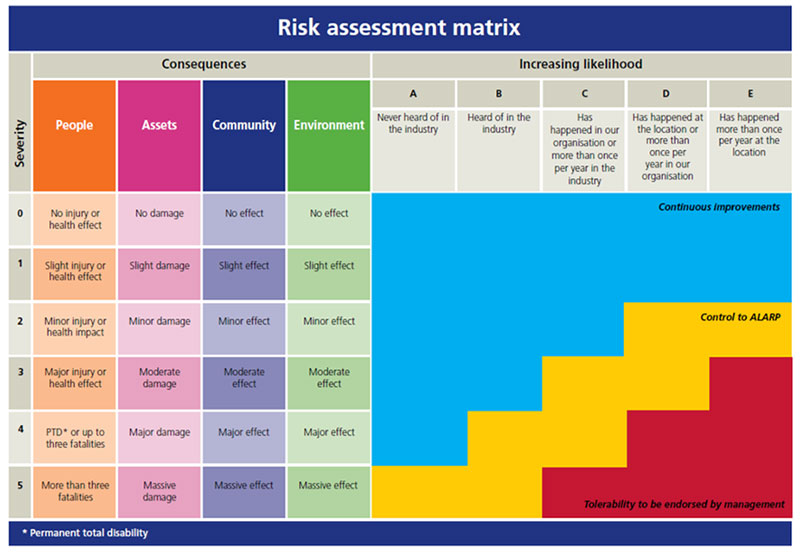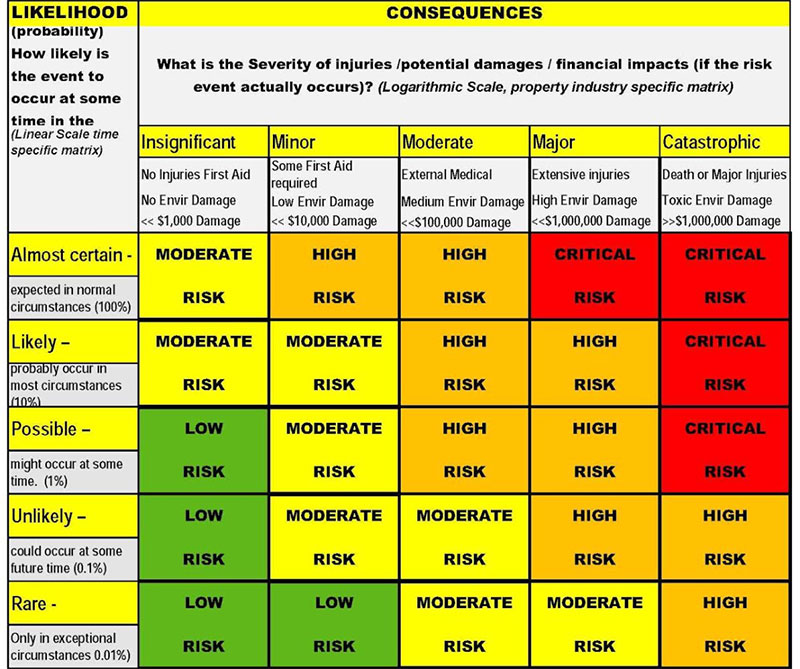The Decision Making Matrix Assesses Risk Based on Likelihood and
Two ways the Decision Making Matrix is used to consider risk. I p is the identity matrix for pth risk factor MG is the membership grade matrix for pth risk factor.

Risk Assessment Likelihood Impact Pratum
An example is the scenario with the strong healthy actively aggressing person.

. The risk matrix has been widely used in risk assessment. Higher risk and lower risk. Using a risk matrix can help measure the level of risk per hazard by considering factors such as the likelihood of occurrence and severity of potential injuries.
Clarify and prioritize options. Through the results it is possible to measure the strengths and weaknesses of a given period. Likelihood of it re-occurring 2.
Severity of every type of risk. A risk assessment matrix is an answer. Likelihood of behavior and possible outcome severity of harm if behavior occurs.
A risk matrix is a risk assessment tool which exposes aspects of risks that could be subjected to some form of ranking. A decision matrix or grid can. Reduce subjectivity in decision making.
The likelihood that someone in this situation would get injured is high and the outcome would probably be severe. Successful decision making requires an understanding of these many requirements. Calculation of fuzzy likelihood matrix.
Decisions evolve around the need to make choices either to do or not to do something or to select one option from a range of options. It is a tool that assists in decision making based on measurement of results. By definition a risk assessment matrix is a method of comparing the probability of a risk occurring- and the impact it may cause to your business.
It teaches us to objectively assess both low and high-risk behaviors so that we can make decisions that de-escalate those behaviors and reduce the likelihood of more severe outcomes. The first step in developing a risk assessment matrix is to make a list of all the operational financial and governmental business risks. In other words it is a tool that evaluates the likelihood vs.
Severity of harm. This method should not be abandoned wholesale but users must address the source of the problem apply the risk matrix with a full understanding of this problem and use matrix predictions to inform but not drive decision-making. It is a tool that assists in reducing the risk.
The risk of doing something and the risk of doing nothing. A Risk Assessment Process Determination of risk event LikelihoodProbability qualitativequantitative and Consequence Risk Characteristics and Factors such as Onset and Duration A Risk Representation mechanism Risk Matrix or Heat Map Risk Decisions Prioritization mitigationtreatment. A risk matrix method also called decision matrix risk assessment DMRA technique is a systematic approach used in risk assessment process to determine and to rank the risk level to compare different risks and to define which threats need to be controlled first and to help minimize the probability of potential risks.
A risk assessment matrix is a visible representation of risks to assist a business in decision making and mitigation. Decide on control measure to implement. 1 FL p I p M G p where.
The Risk Matrix also known as the Probability Matrix or Impact Matrix is an effective tool that assists in risk evaluation by considering the probability or likelihood against severity linked with the potential risks of a project. A risk matrix is a matrix that is used during risk assessment to define the level of risk by considering the category of probability or likelihood against the category of consequence severity. Operational business risks are failures related to day-to-day operations that can impede a companys ability to earn.
The elements of Risk-based decision making are. UK Met Office NSWWS 2 provides warnings to civil responder services and the public using a risk-based traffic light colour scheme where risk is. 1-6 7 Step 3Develop Controls And Make Risk Decisions.
It is a mechanism for measuring the level of risk in the matrix model. A fuzzy likelihood FL matrix is calculated for every risk factor 11 as follows. These grids provide analysts with a measurable method for evaluating their options systematically.
A risk level is a type of score that assesses the odds probability of something going wrong and the effect severity of the incident when it occurs. Planners determine the level of risk by using the risk assessment matrix illustrated in table 1-1. P 1 to m m being the total number of risk factors.
The choices available are often constrained by social technical business safety and environmental requirements and objectives. Decision-making grids outline the criteria for making a decision and rank them based on the most important factors. A risk matrix shows the manager and the decision maker a clearer view of what the risk is what is involved in terms of procedural changes costs behavioural adjustments and the like and what amount of time can.
A risk assessment is effective for risk prevention and guidance for decision making. List two ways the decision-making matrix model is used. Describe a method of counterconditioning that you think would remove the fear or make it less intense.
Do you think any of your fears are based on conditioning. Last resort and least restrictive. This is a simple mechanism to increase visibility of risks and assist management decision making.
The Decision-Making Matrix teaches us that a likely behavior or event with a high-severity outcome is higher risk. A risk matrix visualizes risks together with the possible extent of damage and their likelihood of occurring. The Decision-Making Matrix SM is a tool used in CPIs Nonviolent Crisis Intervention 2 nd Edition Training program.
Assign a risk rating to your hazards with the help of a risk matrix.

How To Use The Risk Assessment Matrix To Organize Your Project Better

Risk Matrix 1024x550 Risk Matrix Risk Management Vision And Mission Statement

How To Use The Risk Assessment Matrix To Organize Your Project Better
No comments for "The Decision Making Matrix Assesses Risk Based on Likelihood and"
Post a Comment